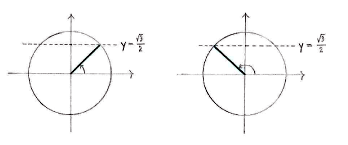Solution 4.4:2a
From Förberedande kurs i matematik 1
We draw a unit circle and mark those angles on the circle which have a y-coordinate of \displaystyle \sqrt{3}/2, in order to see which solutions lie between \displaystyle 0 and \displaystyle 2\pi.
In the first quadrant, we recognize \displaystyle x = \pi/3 as the angle which has a sine value of \displaystyle \sqrt{3}/2 and then we have the reflectionally symmetric solution \displaystyle x = \pi - \pi/3 = 2\pi/3 in the second quadrant.
Each of those solutions returns to itself after every revolution, so that we obtain the complete solution if we add multiples of \displaystyle 2\pi
| \displaystyle x = \frac{\pi}{3}+2n\pi\qquad\text{and}\qquad x = \frac{2\pi}{3}+2n\pi\,, |
where n is an arbitrary integer.
Note: When we write that the complete solution is given by
| \displaystyle x = \frac{\pi}{3}+2n\pi\qquad\text{and}\qquad x = \frac{2\pi}{3}+2n\pi\,\textrm{,} |
this means that for every integer n, we obtain a solution to the equation:
| \displaystyle \begin{array}{llll}
&n=0:\quad &x=\frac{\pi}{3}\quad &x=\frac{2\pi }{3}\\[5pt] &n=-1:\quad &x=\frac{\pi}{3}+(-1)\cdot 2\pi\quad &x=\frac{2\pi}{3}+(-1)\cdot 2\pi\\[5pt] &n=1:\quad &x=\frac{\pi}{3}+1\cdot 2\pi\quad &x=\frac{2\pi}{3}+1\cdot 2\pi\\[5pt] &n=-2:\quad &x=\frac{\pi}{3}+(-2)\cdot 2\pi\quad &x=\frac{2\pi}{3}+(-2)\cdot 2\pi\\[5pt] &n=2:\quad &x=\frac{\pi}{3}+2\cdot 2\pi\quad &x=\frac{2\pi}{3}+2\cdot 2\pi\\[5pt] &\phantom{n}\vdots &\phantom{x}\vdots &\phantom{x}\vdots \end{array} |

